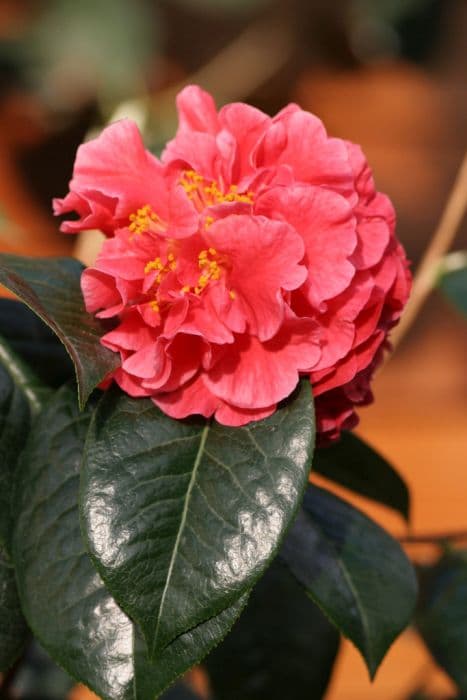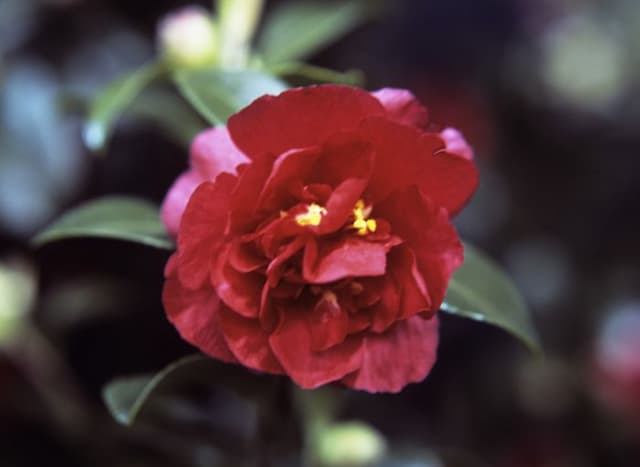Nicky Crisp Camellia Camellia 'Nicky Crisp' (japonica × pitardii)

ABOUT
Camellia 'Nicky Crisp' is a beautiful flowering plant recognized for its delicate and elegant blooms. The flowers are a soft pink hue, with petals that are subtly ruffled, giving them a distinctive charm. These petals are arranged in a formal, semi-double pattern, offering a pleasing symmetry to the bloom. The flowers tend to have a central cluster of golden stamens that contrast stunningly against the pastel pink petals, adding a touch of brightness to the overall appearance. The foliage of the Camellia 'Nicky Crisp' adds a rich green backdrop to its showy flowers. The leaves are glossy and have a leathery texture, contributing to the plant's evergreen nature. They are typically broad, with a slightly elliptical shape and finely serrated edges, providing a lush and vigorous look throughout the year. Overall, the aesthetic of Camellia 'Nicky Crisp' is one of classic beauty with its combination of delicate pink blossoms and lustrous green leaves. This plant is highly appreciated for its ornamental value, gracing gardens with its refined and long-lasting floral display.
About this plant
 Names
NamesFamily
Theaceae
Synonyms
Nicky Crisp Camellia
Common names
Camellia japonica × Camellia pitardii.
 Toxicity
ToxicityTo humans
Camellia 'Nicky Crisp', commonly known as Camellia, is not considered to be a toxic plant to humans. Generally, ingestion of Camellia flowers or leaves does not cause serious harm or poisonous effects. Thus, there are no specific symptoms of poisoning associated with this plant for humans since it is not classified as a poisonous plant.
To pets
Camellia 'Nicky Crisp', commonly referred to as Camellia, is also not considered highly toxic to pets such as dogs and cats. The ingestion of Camellia plants may sometimes result in gastrointestinal upset, such as vomiting or diarrhea, due to the natural plant compounds. However, these symptoms are often mild and do not typically lead to serious toxicity. It is always advisable to monitor pets if they consume plant material and consult a veterinarian if any concerning symptoms arise.
 Characteristics
CharacteristicsLife cycle
Perennials
Foliage type
Evergreen
Color of leaves
Green
Flower color
Pink
Height
6-10 feet (1.8-3 meters)
Spread
6-10 feet (1.8-3 meters)
Plant type
Shrub
Hardiness zones
7-9
Native area
Japan China
Benefits
 General Benefits
General Benefits- Aesthetic Appeal: Camellia 'Nicky Crisp' has beautiful, delicate pink flowers that provide a lovely visual display when in bloom.
- Seasonal Interest: It flowers during the late winter to early spring, offering color and interest during a time when many other plants are dormant.
- Landscape Versatility: With its compact habit, it is suitable for small gardens, can be used as a specimen plant, or integrated into mixed borders.
- Ease of Care: Once established, it requires minimal care beyond occasional watering and pruning to maintain its shape.
- Evergreen Foliage: The plant maintains its glossy green leaves throughout the year, providing constant foliage when deciduous plants have lost their leaves.
- Wildlife Attraction: Bees and other pollinating insects are attracted to the flowers, making it a beneficial plant for supporting local ecosystems.
- Tolerant of Partial Shade: It can thrive in various light conditions, making it a versatile choice for garden spots that receive less sunlight.
 Medical Properties
Medical PropertiesThis plant is not used for medical purposes.
 Air-purifying Qualities
Air-purifying QualitiesThis plant is not specifically known for air purifying qualities.
 Other Uses
Other Uses- Photography Prop: Camellia 'Nicky Crisp' flowers can be used as an elegant backdrop or subject in botanical photography due to their delicate and pastel coloring.
- Pressed Flower Art: The petals of Nicky Crisp can be pressed and used to create beautiful and intricate designs in pressed flower art projects.
- Edible Decorations: The non-toxic petals of Nicky Crisp can be used to adorn cakes and pastries for a colorful, floral presentation.
- Tea Flavoring: While not a common use, the petals of the Nicky Crisp camellia could be experimented with in small quantities for flavoring teas, given camellia sinensis is used for tea making.
- Handmade Paper: The fibers from Nicky Crisp camellia petals and leaves can be incorporated into handmade paper for a unique texture and appearance.
- Perfumery: Although not a common source for scent, the gentle fragrance of Nicky Crisp flowers can be infused in homemade perfumes or potpourris.
- Dye Source: The petals of the Nicky Crisp contain pigments that may be used to naturally dye textiles or paper products in craft projects.
- Bookmarks: Dry and laminate the camellia flowers to create personalized and aesthetic bookmarks.
- Botanical Ice Cubes: Freeze the small petals of Nicky Crisp in ice cubes to add a touch of elegance to cold beverages or punch bowls.
- Cultural Ceremonies: In certain cultures, the blooms of the Nicky Crisp could be used in ceremonies or celebrations as a symbol of affection or admiration.
Interesting Facts
 Feng Shui
Feng ShuiThe Camellia is not used in Feng Shui practice.
 Zodiac Sign Compitability
Zodiac Sign CompitabilityThe Camellia is not used in astrology practice.
 Plant Symbolism
Plant Symbolism- Perfection and Excellence: The camellia flower is often associated with perfection due to its impeccable petals and lush appearance. 'Nicky Crisp' with its delicate pink hue exemplifies these attributes.
- Admiration: Gifting someone a camellia is a way to express admiration for their accomplishments and qualities. The 'Nicky Crisp' variety, with its distinct blend of japonica and pitardii traits, emphasizes this message.
- Love and Affection: Camellias generally symbolize love, affection, and devotion. The soft pink shades of 'Nicky Crisp' evoke gentle and romantic feelings.
- Longevity and Faithfulness: Thanks to the camellia's ability to bloom over a long period, it sometimes represents the endurance of love over time, making 'Nicky Crisp' an ideal symbol of lasting affection and loyalty.
 Water
WaterCamellias require consistent moisture, so the Camellia 'Nicky Crisp' should be watered when the top inch of soil feels dry, which generally amounts to once every week, although this can vary with the climate. It is best to water deeply, providing about 1 to 1.5 gallons of water per session to ensure moisture reaches the roots. During the growing season, especially in dry spells, watering frequency should be monitored closely to maintain soil moisture, but be careful not to overwater as Camellias do not like soggy soil. In the winter, water less frequently, but do not let the plant dry out completely.
 Light
LightCamellia 'Nicky Crisp' thrives in partial shade to filtered sunlight, which means a spot that receives morning sunlight with afternoon shade, or light dappled through overhead foliage is ideal. Avoid direct, intense afternoon sun as it can scorch the leaves and flowers of the Camellia. An eastern exposure that provides gentle morning light is often considered perfect for this plant.
 Temperature
TemperatureCamellia 'Nicky Crisp' prefers a temperate climate and does well in temperatures between 40 and 85 degrees Fahrenheit. They can endure short periods of colder weather down to about 20 degrees Fahrenheit and should be protected from frost. Ideal temperatures for growth and flowering are between 60 and 70 degrees Fahrenheit.
 Pruning
PruningPrune your Camellia 'Nicky Crisp' to remove dead or weak wood and to shape the plant, which is best done after flowering has finished in the spring. Pruning encourages healthy growth and air circulation within the plant. Thin out dense areas and trim back overly long branches, but note that heavy pruning is seldom necessary. Prune every year or every other year as needed to maintain a tidy appearance.
 Cleaning
CleaningAs needed
 Soil
SoilThe Camellia 'Nicky Crisp' prefers well-draining, acidic soil with a pH between 5.5 and 6.5. An ideal soil mix can be created using equal parts of peat moss, pine bark, and perlite or sand to ensure good aeration and drainage. Regularly check the soil's pH and amend with sulfur or peat moss if it starts to become too alkaline.
 Repotting
RepottingCamellias typically require repotting every 2 to 3 years as they outgrow their current containers or the soil becomes exhausted. The best time to repot Camellia 'Nicky Crisp' is in late winter or early spring, taking care not to disturb the roots too much during the process. General signs that repotting is needed include roots circling the pot or emerging from drainage holes.
 Humidity & Misting
Humidity & MistingCamellia 'Nicky Crisp' thrives in moderate to high humidity levels, around 40-60%. In dry environments, increasing humidity can be achieved by using a humidifier or placing a water tray with pebbles near the plant. It's important not to let the pot sit in water as this may cause root rot.
 Suitable locations
Suitable locationsIndoor
Place in bright, indirect light and maintain humidity for indoor Camellia 'Nicky Crisp'.
Outdoor
Plant in partial shade, protect from strong winds for outdoor Camellia 'Nicky Crisp'.
Hardiness zone
7-9 USDA
 Life cycle
Life cycleThe life of Camellia 'Nicky Crisp', commonly known as Nicky Crisp Camellia, begins with seed germination, where conditions must be warm and moist for the seed to sprout and form a small seedling. The seedling phase involves the establishment of a root system and the growth of the first true leaves, gradually developing into a young plant. As it enters the vegetative growth stage, the camellia focuses on producing more leaves, stems, and branches, becoming a mature shrub. The mature Camellia 'Nicky Crisp' then enters a flowering phase, typically starting in late winter or early spring, producing its distinctive light pink, peony-like flowers. After pollination, the plant develops seed pods, which eventually open to release seeds, completing the reproductive cycle. As a perennial plant, this camellia may continue to grow and cycle through these stages for many years, with proper care and favorable conditions.
 Propogation
PropogationPropogation time
Spring-Early Summer
For the Camellia 'Nicky Crisp', often referred to simply as "Camellia", the most popular method of propagation is by semi-hardwood cuttings. This process usually takes place in late summer. The cutting should be from a current season's growth and taken with a heel if possible. The cutting, which is 4 to 6 inches long, needs to be treated with a rooting hormone to encourage the development of roots. It is then placed in a potting mix of peat and perlite or sand to facilitate drainage. The environment should have high humidity and the soil should be kept consistently moist but not wet. Rooting can take several months, and once rooted, plants can be gradually acclimatized to less humid conditions before potting on.









